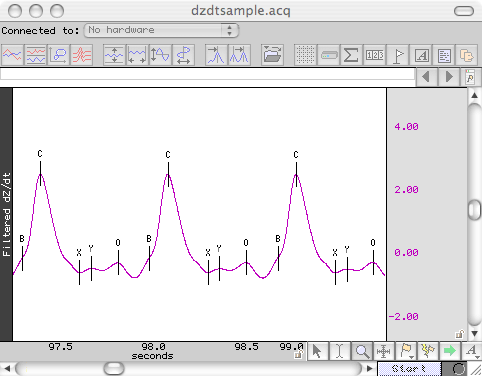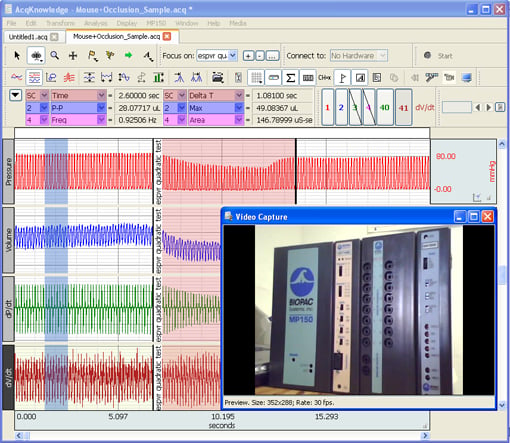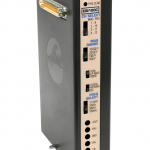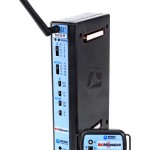Set up and recording is streamlined via intuitive hardware and software controls.
AcqKnowledge software utilizes guided channel setting dialogs, allowing the user to easily input channel data parameters. Once parameters are established, recording settings can be saved as a graph template for future use. This allows for instant startup for subsequent recording sessions.
During recording, see real-time live raw ICG data as well as real-time filtering or calculation channels. Easily insert markers for different stimuli presentation or experimental conditions throughout recording.

dZ/dt Filtered Data with Markers
ICG and other physiological data can also be synchronized to video recording via BIOPAC Camera Systems. With Camera Systems ICG data and Video Data are time linked in AcqKnowledge. Simply scroll through either the video or physiological data to be taken to the corresponding data point in the other file.

AcqKnowledge Data with Time-Synchronized Video
After recording, take advantage of fully automated ICG analysis routines in AcqKnowledge. Use guided video tutorials to get the most out of all available analysis tools.
ICG Automated Analysis Package Overview
Body Surface Area
Determines the body surface area estimation, in square meters, for a subject of a given height and weight. Can be used to calculate body surface area independent of any of the other analysis routines, which may be useful for validation purposes or derived calculations.
Derive dZ/dt from Raw Z
Utility for working with impedances recorded using the BIOPAC EBI100C amplifier or the raw impedance output of the BIOPAC NICO100C module. When computing derivatives from raw impedance signals from an EBI100C, this routine applies appropriate filtering for a thoracic impedance signal and properly inverts the derivative to match traditional dZ/dt presentation.
dZ/dt Classifier
Places events at common inflection points on a dZ/dt waveform to derive other measures.
The classifier locates the following points on the ICG signal:
- B point – opening of aortic valve (set location in Preferences)
- C point – Maximum left ventricle flow (set location in Preferences)
- X point – Closing of aortic valve (set location in Preferences)
- Y point – Closing of pulmonal valve
- O point – Widest opening of mitrial valve
Full ICG Analysis
The ICG Analysis routine includes 20 derived impedance and hemodynamic measures. The ICG Analysis output options allow user to toggle the output of individual measures on and off. ICG Analysis performs a full impedance cardiography analysis on data, extracting intervals and derived cardiac measures. The minimal set of signals required to run this analysis is an ECG Lead II signal and either a raw impedance signal or a dZ/dt signal. In addition to the minimal set of signals, it is also possible to use arterial blood pressure, central venous pressure, and pulmonary arterial pressure signals to improve the quality of the algorithm results. If any of these signals are not present, default fixed estimated values can be substituted for the mean pressures instead of deriving pressures on a cycle-by-cycle basis.
ICG Analysis will produce the following information on a cycle-by-cycle basis:
- Acceleration index (ACI) – Maximum blood acceleration
- Cardiac index (CI) – Normalized cardiac output
- Cardiac output (CO) – Volume of blood pumped each minute
- Heart rate (HR) – Heart rate in BPM as computed from the RR interval.
- Left cardiac work (LCW) – Work exerted by the left ventricle each minute
- Left cardiac work index (LCWI) – Normalized left cardiac work
- Left ventricular ejection time (LVET) – Time interval between aortic valve open and close (time interval between B and X points).
- Mean blood pressure (MBP) – Mean blood pressure as measured on the arterial blood pressure signal, or fixed estimate if no ABP signal is present.
- Mean central venous pressure (CVP) – Mean central venous pressure over cycle, or default value if no CVP signal is present.
- Mean pulmonary arterial pressure (PAP) – Mean value of the pulmonary arterial pressure of a cycle, or default value if no PAP signal is present.
- Pre-ejection period (PEP) – Time interval between systole and aortic valve open (time interval between the Q wave of the ECG and the B point of the ICG).
- RR interval (RR-i) – Time interval between R peaks in the waveform
- Stroke index (SI) – Normalized stroke volume
- Stroke volume (SV) – Volume of blood pumped by left ventricle in a single beat
- Systemic vascular resistance (SVR) – Afterload; arterial flow resistance
- Systemic vascular resistance index (SVRI) – Normalized afterload
- Systolic time ratio (STR) – Ratio between electrical and mechanical systole
- Thoracic fluid content (TFC) – Electrical conductivity of the chest cavity
- Thoracic fluid index (TFI) – Mean value of the raw impedance over the cycle, or fixed baseline value if no raw impedance signal is present.
- Velocity index (VI) – Maximum velocity of blood flow in the aorta
Ideal Body Weight
Body Weight is derived from a person’s height, gender, and frame size (using the Metropolitan Life Insurance Tables method). It describes the ideal weight based upon various estimates. Ideal body weight is subject to interpretation, so a number of methods are provided. Ideal Body Weight results are expressed in kilograms.
Pre-Ejection Period (PEP)
The Pre-ejection Period analysis tool helps extract PEP measurements from ECG Lead II and ICG data. The pre-ejection period is the time interval between the electromechanical systole and the onset of ejection of blood from the left ventricle of the heart. PEP can also be computed using the full ICG Analysis tool.
The PEP analysis will output the following information on a cycle-by-cycle basis:
- Heart Rate
- PEP
- R-R Interval
Remove dZ/dt Motion Artifacts
This routine applies SFLC motion artifact removal to a dZ/dt signal using cycle information from an ECG signal to construct a sinusoidal model of the ICG signal containing only components that are correlated to the heart rate. This tool performs the same type of filtering as the ICG Analysis and Pre-ejection Period tools when the Motion Filtering preference is enabled.
VEPT
This analysis computes the volume of electrically participating tissue (VEPT) in cubic centimeters of a subject using the truncated cone method. It can be used to calculate VEPT independent of any of the other analysis routines, which may be useful for validation purposes or other derived calculations.
Learn More—watch the AcqKnowledge ICG Routines tutorial.
Get Started!
Record up to 16 channels of high-fidelity ICG and/or Cardiac Output and other physiological data either wirelessly with BioNomadix or via standard wired amplifiers. Contact BIOPAC today to customize a complete package with amplifiers, leads, electrodes, and/or transducers for your application.
- View available MP Research Starter Systems
- Purchase a standalone copy of AcqKnowledge for Windows or Mac




Stay Connected